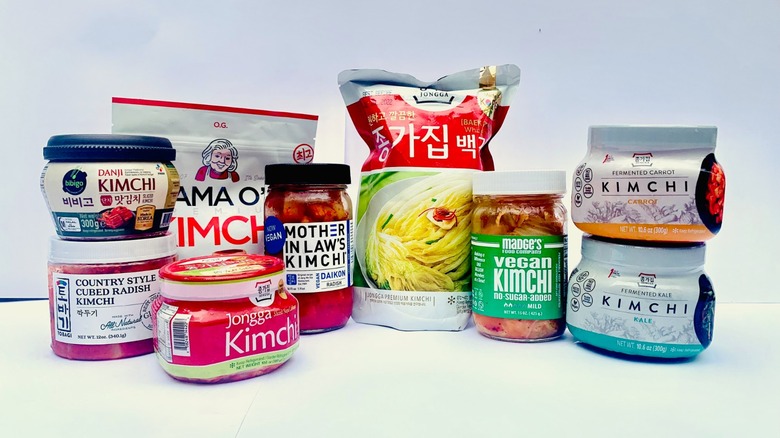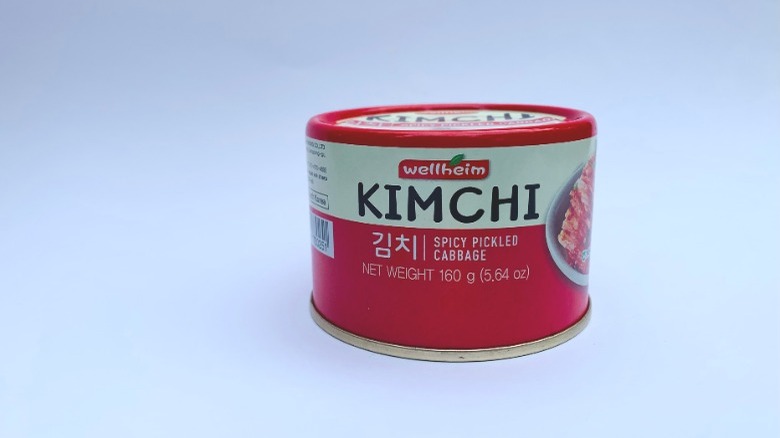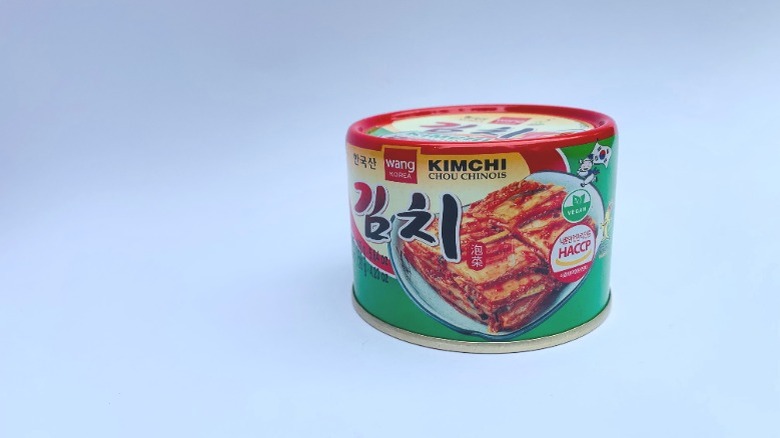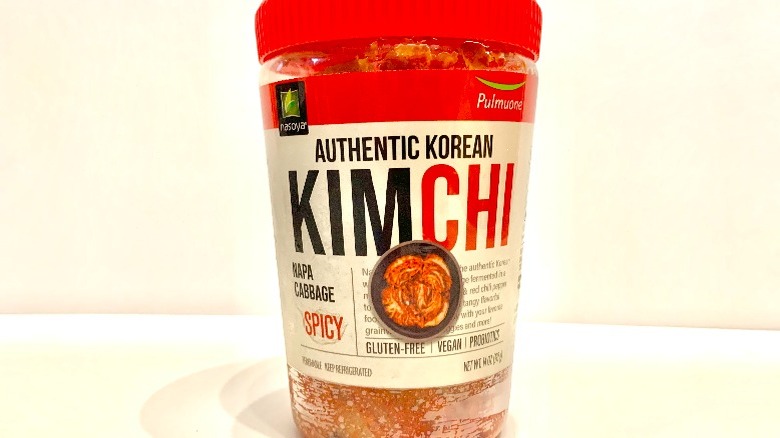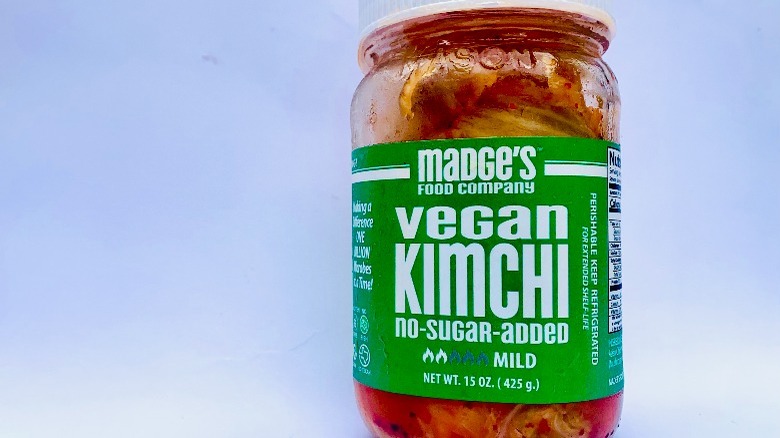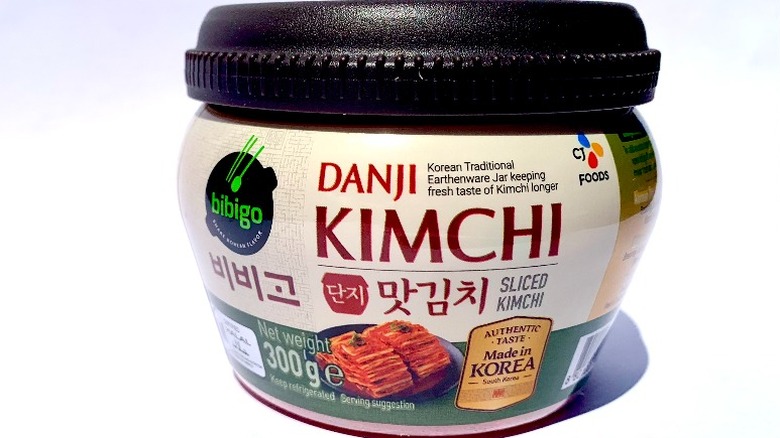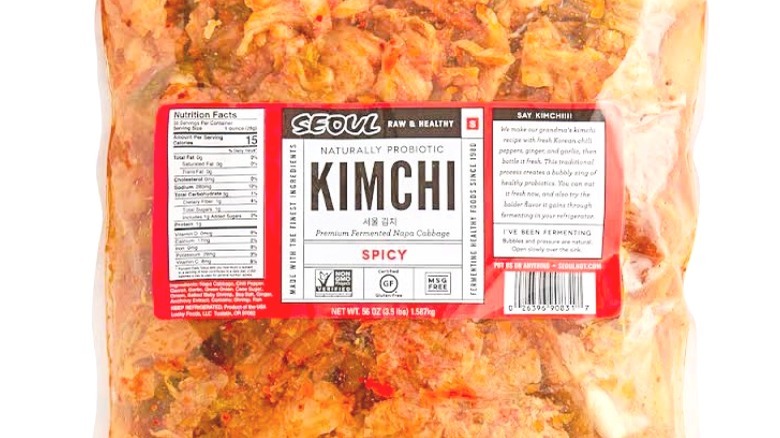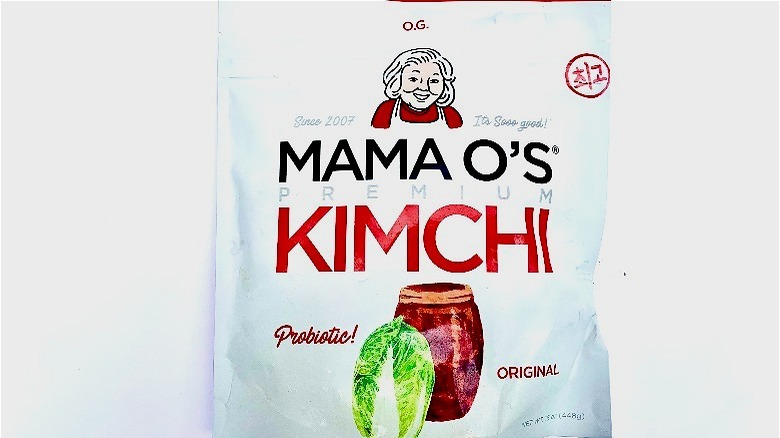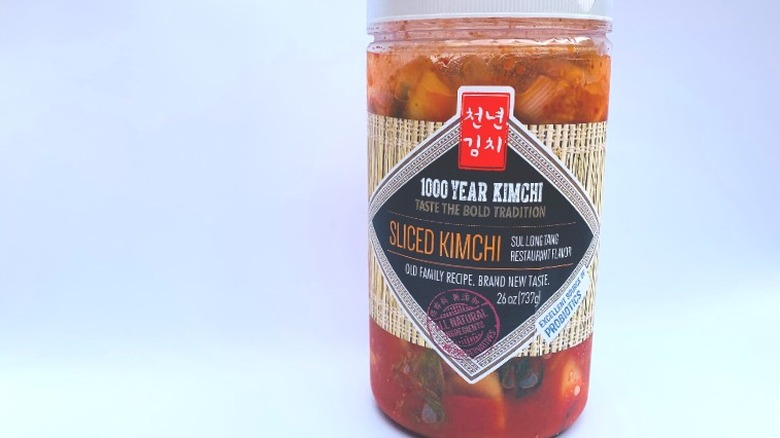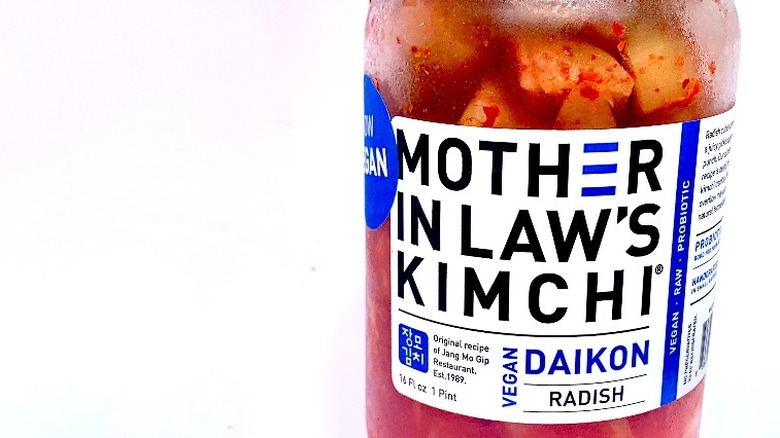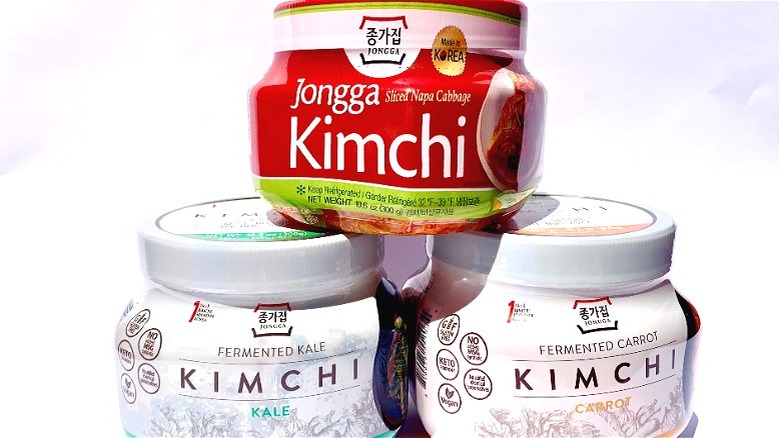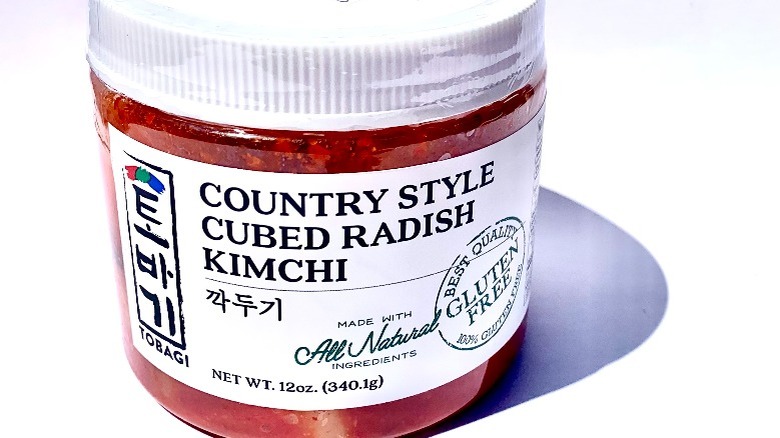The Best Kimchi Brands Ranked
Kimchi is a spicy, fermented Korean staple. Classically, the food has a cabbage or radish base fermented with gochujang, garlic, ginger, and then anchovy, shrimp, or fish sauce for umami. Kore Limited explains that kimchi emerged from necessity. To have food during the harsh winters, early Koreans would preserve food by salting and burying them. The first kimchis were made from radishes, but during the Goryeo Period, trade boomed, and Napa cabbage found its way to Korea, granting the opportunity for many new, different types of kimchi. Early Koreans discovered that the vegetables were naturally fermenting, allowing them to develop umami layers and a crisp, refreshing crunch that tingles the tongue with tang and spice. From there, kimchi became one of the most important dishes in Korea, and now kimchi brands abound.
According to BBC News, the dish is so integral that when South Koreans launched its first astronaut to space in 2008, mission control sent kimchi with her. Beyond an important cultural place, kimchi's fermented nature is of high nutritional value. The fermentation is created by ambient Lactobacillus bacteria, the same active ingredient in yogurt (via Live Eat Learn). Fermented products are incredibly beneficial as they naturally produce probiotics that aid a healthy gut. Plus, Napa cabbage is an excellent source of vitamins K, C, and folate.
Eaters can incorporate kimchi into any dish, but it is also a perfect side or a topping to add renewed flavors to your meal. While there are many traditional recipes like kimchi jjigae or kimchi fried rice, the foodstuff can elevate various things, such as your brunch beverage — kimchi bloody mary, anyone? That said, it is important to know which popular kimchi brands will rocket you to the stars.
11. Wellheim
Coming from a can, Wellheim kimchi tastes almost synthetic. To add ingredients like high-fructose corn syrup and Monosodium L-Glutamate (MSG) to a health food product seems counterintuitive. According to Healthline, MSG is a flavor enhancer that mimics umami. For a long time, MSG was linked to many severe health risks. Many of those links have been disproven; however, it is still regarded to be responsible for headaches and other minor afflictions. In our opinion, beyond the risk involved — it just seems lazy. With so many more natural enhancers at its disposal, it doesn't add up ... unless that is exactly the reason for its use — that it is the more cost-effective option.
The other ingredients are Napa cabbage, water, red chili pepper, garlic, ginger, salt, cane sugar, and high fructose corn syrup. Plus, salt, in addition to MSG. It is no surprise that it comes across as unbalanced and inauthentic. Extreme saltiness is only tempered with cloying sweetness with little else going on. The cabbage is soggy and sour.
A part of the NongHyup Corporation, which is involved in the production, distribution, and sales activities of agricultural products in Korea, one might expect more in the use of fresh produce rather than preservatives. Again, the pros of this product are the price point and ease of shipping due to it being shelf-stable. It is not super easy to find, but it is on Amazon.
10. Wang
Also sold in tin cans, Wang is already less aesthetically pleasing than most other kimchi brands. Traditionally, kimchi was served in earthenware jars called "onggi," according to Maangchi, and now shoppers can find it in glass, vacuum-sealed packages, and many other vessels. Still, a tin can (like you would buy deviled ham) is not very appealing.
As the ingredient label shows, Wang has an abundance of preservatives. You'll notice when kimchi shopping that all kimchi is in the refrigerated section, but Wang is shelf-stable. That translates into a taste and texture which is overly salty with a bitter edge and mushy feel. The (many) ingredients sound far less fresh than its competitors — salted Napa cabbage, refined water, kimchi sauce, radish, red pepper powder, sugar, garlic, onion, apple puree, carrot, green onion, refined salt, ginger, sorbitol, vitamin C, and xanthan gum. On the plus side, this is a more cost-efficient choice, and it is easy to come by. Plus, the fact that it is shelf-stable means it is a breeze to ship.
9. Nasoya
Nasoya began as a tofu company that grew to become the number one seller of the soy foodstuff in all of America. The brand expanded to make a number of Asian-inspired foods, including dumplings, noodle bowls, and low-carb noodles. In 2016, Nasoya was acquired by Pulmuone Foods, which is when it began the kimchi journey.
Its mission is to make plant-based foods accessible to all, and the company has done a great job. There was a time when Nasoya was one of the few companies of its kind out there. While its line of products is fantastic, sadly, that does not include kimchi. It is not offensive — in fact, this kimchi has a vibrant crunch and freshness, but the spice and umami fall by the wayside. The magic of kimchi is the superfecta of sour, spice, umami, and crispness, and this can did not tap into all four. Made with Napa cabbage, radish, red pepper powder, pear, garlic, and salt — perhaps a mushroom and sea vegetable mixture for umami would have found a good use and upped the ante?
This kimchi is still a nice option to top on salads, sandwiches, and many other foods, but it is a little milquetoast.
8. Madge's Food Company
Madge's is a fermented food company out of San Antonio, Texas. While this is not your traditional Korean kimchi company, it makes a heck of a kimchi! This isn't a brand confined to your favorite Asian supermarket, but rather one that hungry kimchi fans can also find at larger stores like Whole Foods. Madge's product line runs the gamut of fermented foods and even includes a fermented bloody mary mix.
Madge's kimchi line has a classic style, a spicy Napa cabbage version, a mild variety, and a cucumber kimchi. All three are vegan and do not contain sugar. The recipe swaps out fish-based ingredients for a combination of shiitake mushrooms and sea vegetables, creating a vegan alternative blossoming with flavor. The Mushroom Council (yes, there's a mushroom council) states that mushrooms are an excellent source of umami and that the hue of the mushroom is important to this trait. Mushrooms with darker caps contain more umami. The most umami-packed, widely-available mushrooms are shiitake, portabella, crimini, and white button. Madge's ferments its kimchi for a longer cycle than most other brands to increase the health benefits — it also increases the brininess. The result is more of a pickled flavor — sour and saline. It is fresh tasting and lively, but the depth of richness and funk is lacking. It is still super yummy if rather un-kimchi-like.
This kimchi comes in a glass jar, and if you have it delivered, you will find it in a plastic bag wrapped in more plastic and then covered in bubble wrap. Madge's will enclose a note, "Please refrigerate your products immediately! They have been cramped up in a little dark box for a few days with nobody to talk with. Wouldn't you be a little grumpy too?" As you unwrap your kimchi, you may find it has leaked, which the note says is normal due to increased fermentation during shipping. The company suggests you "burp" it after chilling it to release the CO2 buildup.
7. Bibigo
The name Bibigo comes from the Korean word bibim, meaning to mix, and the English word go. According to its website, bibim represents balance and harmony, while "go" symbolizes the company's ambition to spread the word about Korean food. Bibigo has been in business for over 60 years and believes it holds the title of number one food company in Korea. Bibigo has its own secret seasoning and fermented lactic acid bacteria used to make its kimchi.
Fermented at a constant temperature underground, the lactic acids grow and ferment at an equal rate which helps it to develop a deep and complex flavor while keeping the cabbage crisp. The chili powder brings a mouthwatering vibrancy while pear tempers the heat with a bit of sweetness, and fermented fish gives it depth and savouriness.
Bibigo is also the official sponsor of the CJ Cup, Korea's only official PGA Tour tournament. To align the brand with the health and sports scene, parent company The CJ Group has hosted the CJ Cup since 2017. The event is designed to create a place where Korean golfers compete with world-class players. The brand hopes to build itself into a cultural sports platform and introduce athletes to authentic and modern Korean foods along the way.
6. Seoul
Seoul Kimchi stands out immediately with a hip package vibe featuring a graffiti-like font and neon colors. Seoul is part of Lucky Foods, owned by the Jo family, who immigrated to the United States from Korea in the 1970s. Lucky Foods began as a restaurant and later became a manufacturer of original Korean products.
The Seoul Kimchi line of fermented foods is always MSG and GMO-free, and the company caters to current food trends, mentioning that its kimchi is paleo and keto-friendly. The range of products includes original, spicy, vegan original, vegan spicy, and radish.
Seoul Kimchi comes in either a BPA-free bag or glass jar. The original spicy ingredients are Napa cabbage, gochujang Korean chili, carrot, garlic, green onion, cane sugar, onion, salted baby shrimp, sea salt, ginger, and anchovy extract. This kimchi is very mild in spice and heavy on the tang. The cabbage has a nice, crunchy texture and snaps when you chomp into it. All kimchis evolve throughout storage and eating periods; however, this one, in particular, starts a little weak. But, it gains a distinct funk and tartness over time. We can even suggest leaving it at room temperature until it ferments more before enjoying it. Seoul Kimchi varieties are incredibly easy to find, sold at Target, on Amazon, and of course, on the Lucky Foods website (among other shops).
5. Mama O's
Mama O's is named for the founder, Kheedim Oh's mother, who taught him the art of kimchi-making through her special recipe. Based in Brooklyn, Oh never aspired to start a food brand. Despite this, the Fermentation Association reports that Mama O's Premium Kimchi was born in 2007. As many might recall, this was amid The Great Recession. Struggling to get by, Oh began making huge glass jars of kimchi and precariously transporting them to restaurants and stores via his skateboard.
As a former DJ, Oh combines his two passions with Kimchipalooza, an annual festival in Brooklyn with live music and kimchi-centric tastings, demos, and DIY workshops.
Oh's recipe is classic kimchi, but with a twist of lime. It is made with Napa cabbage, fish sauce, onion, daikon radish, cilantro, scallions, and Mama O's premium OG kimchi paste. You might notice another outlier — cilantro — but what makes this kimchi truly unique is the fresh lime juice featured prominently in the proprietary kimchi paste. The mixture consists of water, chili pepper, salt, cane sugar, fresh ginger juice, and fresh citrus juice. The lime juice, while not traditional, adds a lot of zest and unique nuance.
Mama O's sells a diverse line that includes white kimchi, super spicy, daikon radish, baby bok choy, vegan and original. Its website has several recipes to make using the kimchi, and the company even has a DIY kimchi kit!
4. 1000 Year
1000 Year Kimchi might be tough to find but worth the search. The brand makes its kimchi in the Sul Long Tang method, in which kimchi is sliced and flavored specifically to serve alongside Korean beef bone soup, known as seolleongtang. Go Szechuan House describes the dish as a thick and creamy white broth made by boiling down cattle leg bones for several hours. The bite of kimchi provides a refreshing contrast to the rich, collagen-filled broth.
Visually, 1000 Year Kimchi is stunning — it is sprightly and brilliant in fire engine red and bright green colors. The kimchi has an ingredient list of Napa cabbage, hot pepper powder, garlic, salt, radish, sugar, anchovy sauce, onion, ginger, scallion, sweet rice powder, and salted shrimp. The bacteria used for fermentation is leuconostoc. A little on the sweet side, potentially due to the inclusion of cane sugar in lieu of pear or apple, but otherwise balanced. It is crisp and popping with flavor, with a zippy tingle of spice.
While it is nearly impossible to find considerable information online about this (and many other traditional brands), H Mart visually shows what to expect from certain kimchis with its video series. This short clip will make your mouth water, and you may find yourself immediately pulling the nearest H Mart up on Google Maps.
3. Mother-in-Law's
Mother-in-Law's is a crowd favorite. The name comes from the Korean tradition of welcoming a bride to the husband's family by allowing the mother-in-law to teach her the family's kimchi recipe, per company info. According to the website, founder Lauryn Chun launched her first kimchi in 2009. This kimchi, called House, was based on an original recipe from her mother's family restaurant, Mother-in-Law's House (Jang Mo Jip) in Garden Grove, California. Accordingly, it is still its best seller.
The House kimchi traditional recipe is made with Napa cabbage, red chile pepper, onion, scallion, chives, salt, sugar, garlic, ginger, anchovy sauce, salted shrimp, bone broth, sesame seeds, and rice flour. It is super bright and complex and gives a burst of resisting texture when you bite in. Balanced in flavor and feel, House tastes as if there is pear added, as some brands do. But it's cane sugar that gives the lift. The bone broth, anchovy paste, and shrimp provide depth and savoriness, while other ingredients offer spice, crunch, earthiness, and liveliness.
Mother-in-Law's also has a range of styles, such as Vegan Daikon Radish and Vegan Table Cut. These are made sans-bone broth or fish. According to its website, hand-cutting vegetables into long strips and chunks ensures a more balanced fermentation and allows for deeper flavors to develop. Mother-in-Law's hand-cut its vegetables, mixes them into small batches, and then packs them in glass jars. Company information reports that hand-cut squares ferment faster, which gives the kimchi a sharpness.
2. Jongga
Jongga is classic Korean kimchi made with Napa cabbage and customary ingredients. These robust ingredients increase complexity as the kimchi ferments, bursting with flavorful heat but delightfully balanced. They are the number one kimchi brand in Korea. The company writes that jongga is a term for the Korean tradition of passing down recipes. Sure enough, Jongga sells its kimchi in more than 60 countries worldwide, so this is an easy brand to snag and share. With a continuous effort to push for the globalization of Korean food, Jongga often takes the opportunity for experimentation.
In addition to the traditional baechu kimchi, the company makes various other types, such as baek kimchi (white kimchi that is not spicy) and even kale and carrot iterations. Jongga classified some of these as "for kimchi beginners" since the variety is less funky and spicy. There are 21 different types to choose from. Jongga also offers a seasonal kimchi line that includes chonggak kimchi (ponytail radish kimchi), yeolmu kimchi (young radish kimchi), and kaktugi kimchi (cut radish kimchi). The classic baechu cabbage kimchi bursts with umami from the anchovy; fresh and crunchy with a sharpening, briny layer. A heating spice comes at the end and startles the tip of your tongue. Each bite is sapid and balanced with alluring aromatics.
Jongga sells its kimchis in every possible packaging — plastic containers, glass jars, vacuum-sealed bags — even massive plastic bags tied up like a goldfish won at the fair. Since its brand of kimchi is widely distributed, it is easy to find a jar of Jongga at your local Asian market, grocery store, or online (and at a reasonable price).
1. Tobagi
Kimchi lovers widely consider Tobagi one of the best varieties in the United States, and we must agree with that general consensus. The key to its superbness may be the production method, using a flavoring mixture consisting of daikon radish, Korean pear, gochugaru (Korean red pepper flakes), and scallions. The thing that makes Tobagi stand out against its competitors is that the brand tediously stuffs the concoction in between each leaf of cabbage by hand.
In addition to the guhchulee ingredients, Tobagi uses shrimp and anchovy for umami and ginger and garlic for an extra oomph in its Napa cabbage-based original recipe. Texturally, it is crunchy and juicy, and the flavors are an equilibrium of umami funk, sweetness, acidic salinity, and heat. The spiciness has a lasting tingle and feels alive. There are quite a few variations of Tobagi kimchi —over 50 according to H Mart. A favorite of many is the Country Style Cubed Radish Kimchi, an homage to the first iterations of kimchi. There are also vegan options, and no matter which you choose, tasting Tobago kimchi feels like a pleasant slap in the mouth. Tobagi can be found at specialty stores like H Mart and Mercato. Try it in a quesadilla, such as this one from Eva Shares Food. The oozy cheese and crisp and tangy spice will balance each other for a delectably unique meal.
